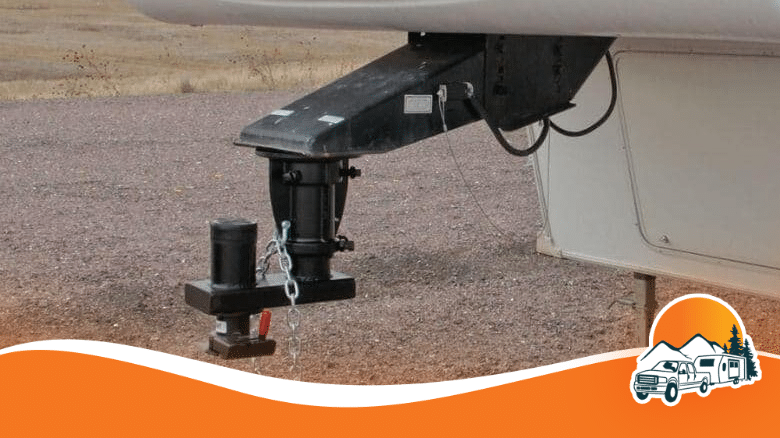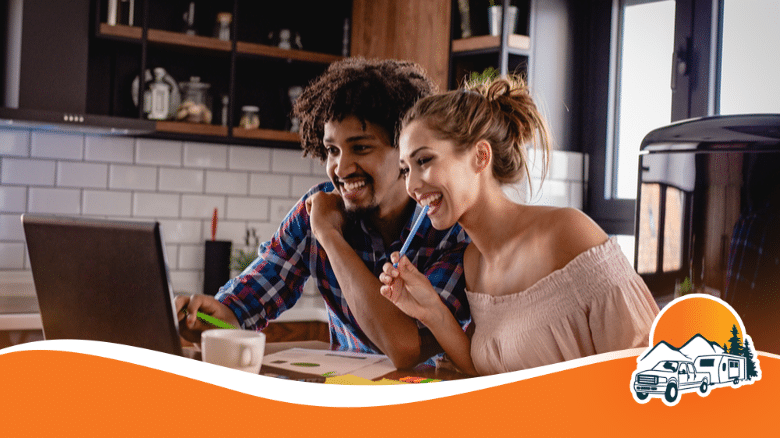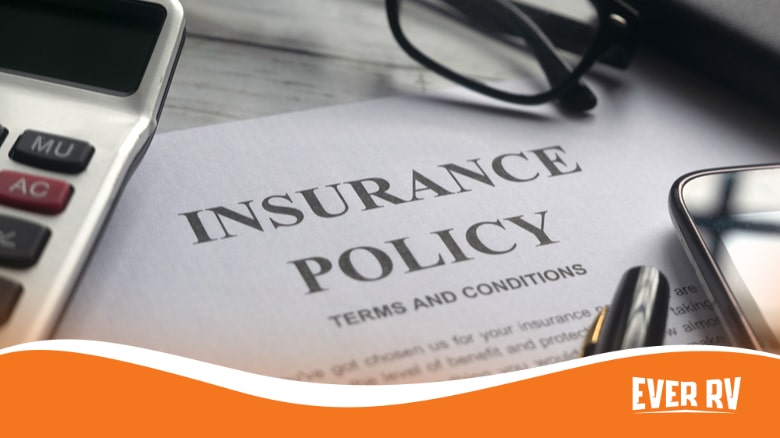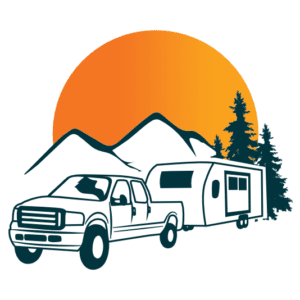While you may have figured out that the fifth wheel makes for an excellent coupling device to join the towing truck and the trailer, you must still be confused about whether you require safety chains to keep your fifth wheel stable.

It would make perfect sense for a fifth wheel to require the stability of these safety chains, right? You’ll be surprised to know that that is not the case.
You do not need safety chains on a fifth wheel simply because the kingpin directly locks the entire RV and all its parts in place. This kingpin is strong enough to hold off any unstable movements and allows for smooth and swift traveling.
- Do Fifth Wheels Require Safety Chains?
- Why Do Safety Chains And Fifth Wheels Don’t Go Together?
- Which Vehicles Require Safety Chains?
- Why Do Vehicles Need Safety Chains?
- Can I Add Safety Chains To My Fifth Wheel?
- Does An Andersen Fifth Wheel Hitch Require Safety Chains?
- Are Safety Chains A Requirement For Fifth Wheels In The US?
- The Final Verdict
Do Fifth Wheels Require Safety Chains?
Fifth wheels do not require safety chains because the kingpin locks the entire vehicle in place and eliminates any need for safety chains.
Every fifth wheel has two main parts: a gooseneck hitch that connects to the towing vehicle and a cargo attachment that connects with the cargo unit of your vehicle.
These units are locked in together by a kingpin, making for a strong connector of both these parts.
The kingpin establishes a highly secure and safe connection and stabilizes the vehicle, allowing you to make swift and effortless turns.
Why Do Safety Chains And Fifth Wheels Don’t Go Together?
Safety chains are designed to stabilize the trailer and are bound to the hitch of the towing unit of the vehicle. Safety chains help the larger vehicles move smoothly on the roads without letting the trailer swing behind.
You can learn more about this over here.
However, safety chains do not go together with fifth wheels, and there are certain reasons for that. Let’s explore those!
#1 Limited Range Of Movement
One challenge that safety chains present is that they limit the pivoting ability of the RVs and result in uneven turns.
Since the safety chains lock everything from the back of the bumper to the front of it, any turning pulls the chain along with it, and that can make it a little unstable when it comes to tricky turning points that require greater pivoting.
The good news is that fifth wheels do not have these safety chains and can allow the RV to make smooth turns without any resistance. This greater range of movement works ideally for your vehicle regarding long turns.
#2 A Hitch Works Better For Your Fifth Wheel
The hitch on your fifth wheel contains two main portions, namely, the gooseneck hitch and the cargo attachment. A kingpin locks in these two portions of the fifth wheel and binds everything together.
This kingpin is a strong, reliable piece of metal, and it holds everything, eliminating any need for safety chains.
The safety chains are generally used for RVs that have a ball hitch, and they require the safety chains because the ball hitch isn’t stable enough to support the vehicle on its own.
These safety chains will hold the ball hitches of the RV in place and prevent any unstable movements in the vehicle.
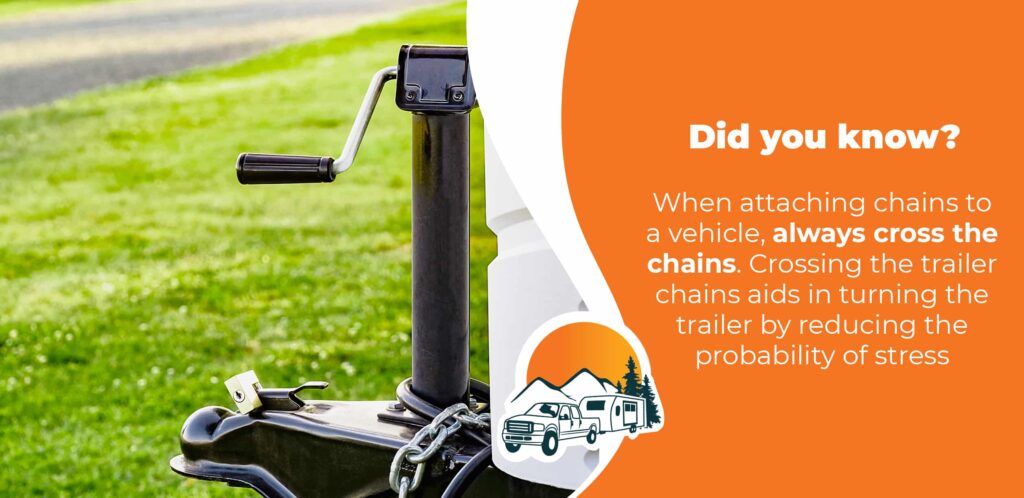
Which Vehicles Require Safety Chains?
You would find only a few vehicles that don’t require safety chains, such as those having a fifth-wheel locking mechanism.
Almost every towing vehicle requires safety chains because most use the ball hitch locking mechanism. All types of camping trailers, toy haulers, and horse trailers are examples of RVs that require the usage of safety chains.
These safety chains are the main factor that pulls forward any trailer, and hence, most towing trailers require these safety chains.
But more importantly, they keep the cargo compartment and towing vehicle bound together and prevent any accidents from occurring, which may result due to excessive swinging or loss of control of the vehicle.
Why Do Vehicles Need Safety Chains?
Most vehicles use the ball hitch mechanism to lock the towing and cargo compartments together, but that ball and hitch linkage might sometimes prove weak, and having a backup such as safety chains could save you from a lot of unwanted problems. Let’s dig a little bit deeper into this.
#1 Prevent Swinging Of The Vehicles
When you plug in the safety chains, they offer backup support to the ball hitch locking system. The round ball sitting inside the round hood could result in excessive movements while moving straight on the road, and your vehicle could be swinging behind you.
Please note that the ball and the hood are round because they enable the RV to make appropriate turns with the slightest exertion.
Your RV swinging around as you move down a straight road can result in the destruction of property. The safety chains play a part in preventing the swinging of your RV and stabilizing its movements.
#2 Provide A Backup Support
The safety chains attach to the hook of the RV and play their part in providing backup support. If there is a problem with the primary coupling of the ball and hitch, these safety chains act as guardians to keep your RV together and prevent them from falling out or breaking away.
These chains attach to the back bumper of the towing vehicle and the front bumper of the cargo vehicle. Please note that these safety chains are not a requirement for the functioning of your RV, but rather, these chains are just placed as a protective measure to tackle any unforeseen circumstances.
#3 Help Avoid Road Accidents
Since the ball hitch locking mechanism is not very stable and can produce swinging of the vehicle even on a straight road, it could potentially result in road accidents.
Driving your RV on a traffic-flooded road without safety chains could be extremely dangerous, and if you’re not careful, it can lead to fatalities and damage to property.
Adding safety chains ensures that these accidents do not happen. These safety chains serve as a protective endeavor because they lock both the parts of the vehicle and limit the swinging arising due to the ball hitch linkage to a considerable extent.
Do you want to be more informed on safety chains? Check this video out.
Can I Add Safety Chains To My Fifth Wheel?
Even though safety chains are certainly not required for a fifth wheel, it is entirely up to you if you still want to go ahead and add safety chains to your fifth wheel.
The fifth wheel has a powerful kingpin mechanism that attaches the trailer and towing vehicle part, but adding safety chains can contribute to extra safety. Moreover, some states in the US require you to have safety chains if your fifth wheel has a ball hitch latching mechanism
Does An Andersen Fifth Wheel Hitch Require Safety Chains?
Since Andersen hitch is a fifth-wheel hitch, it does not require any safety chains. But this is objectionable because the Anderson uses a gooseneck ball to fix the fifth wheel hitch in place, which fixes the fifth wheel and holds it together.
It is important to note that generally, gooseneck trailers require safety chains because they have a latching mechanism in place, which presents the danger of mishaps. Still, Andersen’s fifth wheel hitch uses an entirely different mechanism that allows for firm fixation of the fifth wheel hitch and prevents any excessive pivoting on the road.
However, it is recommended that you get the safety chains installed anyway for extra safety and to avoid any uncomfortable confrontations with the Department Of Transportation (DOT).
Are Safety Chains A Requirement For Fifth Wheels In The US?
It is very much understandable why safety chains are a requirement by law because their absence can cause accidents and damage to property.
While the law may sometimes be different in different states, the generally applicable law to every trailer is that safety chains are a requirement if you have a ball hitch locking mechanism, and that applies to fifth wheels too if they have a gooseneck ball hitch mechanism.
These requirements may not be the same for every state, and sometimes traveling long distances can become a problem.
Therefore, as an additional precaution, you should get safety chains added to your vehicle anyway. You will get extra safety and you do not have to worry about what type of hitch your vehicle has.
The Final Verdict
The good news is that your fifth wheel does not need safety chains and that definitely makes your life easier. Fifth wheels have a strong latching mechanism and they have entirely eliminated the need for safety chains.
The safety chains are thick and strong and are widely used in most RVs. These safety chains are generally required for every vehicle that uses a ball hitch for linkage. Besides helping the towing vehicle pull forward the cargo compartment of the RV, these safety chains also help prevent the swinging of the vehicle and avoid any roadside accidents.
Now that you know that your fifth wheel doesn’t require safety chains, you can easily drive it around without any worries! Life seems a bit easier now, doesn’t it?

